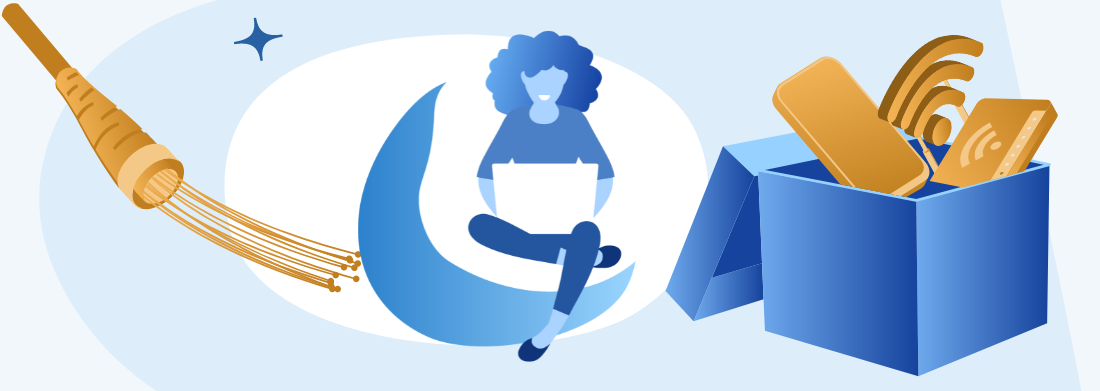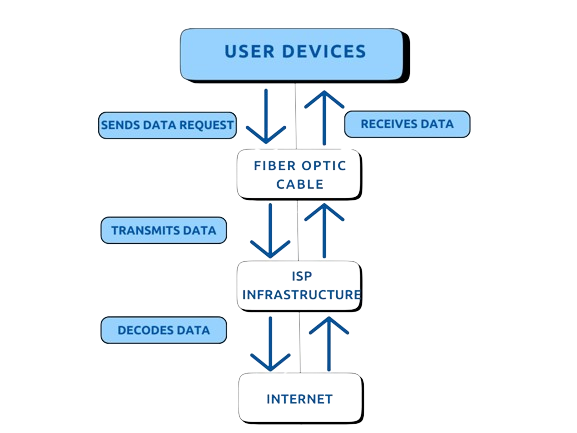Fiber Internet: Find the Best Provider for Your Needs

Are you curious about fiber internet and how it can revolutionize your online experience? Fiber internet, utilizing advanced fiber optic technology, delivers lightning-fast speeds and unparalleled reliability, making it ideal for seamless browsing, streaming, and gaming. In India, top providers like Airtel Xstream and JioFiber offer competitive packages at ₹3999, ensuring you stay connected.
What is Fiber Internet?
Fiber internet, also known as fiber-optic internet, is a type of fast internet connection. It can go really fast, up to 10 Gigabits per second (Gbps) in certain places.
Fiber internet utilizes fiber-optic cables, which are composed of thousands of glass or plastic strands. These strands transmit data as light signals, allowing for a much faster data transfer compared to the traditional copper cables used in DSL(Direct Subscriber line) or cable internet. This technology not only boosts internet service speed but also increases the bandwidth, enabling multiple devices to connect simultaneously without a dip in performance.
- Types of Fiber Optic Cable Internet
- FTTH or FTTP (Fiber to the Home or Premises): This type gives you the fastest internet because the fiber cables go all the way to your house.
- FTTC (Fiber to the Curb): This type brings the fiber to a pole near your house, but then uses a regular cable to get to your home. The use of regular cable slows things down a bit.
- FTTN (Fiber to the Node or Neighborhood): With this type, the fiber cables come close to your house, but not all the way. They stop about a mile away, and the rest of the journey to your house is made through metal wires, which makes this the slowest fiber option.
How Does Fiber Internet Work?
Fiber internet’s working principle revolves around the use of optical fibers to transmit data. Light signals encode data and travel through these fibers over long distances with minimal loss, making fiber internet service vastly efficient and reliable.

When you use the internet, your device sends and receives data, which travels through cables to reach servers that could be very far away. Fiber optic internet uses cables filled with very thin glass strands to move this data. Each strand is super thin, about a tenth the thickness of a human hair, and a cable might have just a few or hundreds of these strands, depending on how many people it needs to serve.
The technology behind fiber optics comes from the 1950s and was first used in medical scopes to let doctors see inside the body without surgery. By the 1960s, this technology was adapted to send telephone calls.
But why use glass?
Glass strands allow data to travel as light, making it very fast—close to the speed of light, or about 186,000 miles per second. In reality, it's a bit slower, around 70% of that speed, but still much faster than other types of internet connections.
Fiber optic cables can also carry a huge amount of information. A single strand can handle 25,000 phone calls at once. That's so fast, you could download everything on Netflix in less than a second.
What Are Key Benefits of Fiber Internet?
- Unmatched Speeds: Fiber internet can deliver speeds up to 1 Gigabits per second(Gbps) which is equivalent to 1000 Megabits per second (Mbps), significantly faster than traditional broadband. This internet service speed facilitates streaming, gaming, and downloading, even with multiple devices connected.
- Reliability and Stability: Fiber-optic cables are less susceptible to weather conditions and electromagnetic interference, ensuring a stable connection.
- Symmetrical Speeds: Unlike other internet types, fiber offers symmetrical upload and download speeds, essential for cloud storage, video conferencing, and online gaming.
- Future-Proof: As digital demands grow, fiber internet’s infrastructure is best suited to handle future advancements and higher data loads.
Internet plans are typically rated by download and upload speeds. Download speed shows how fast your internet can bring data from far-away servers to your device, while upload speed does the opposite.
Comparing Fiber With Other Types of Internet
Fiber internet is different because it uses light to send data through glass fibers instead of electricity like other types of internet. Over the years, internet has changed a lot. We went from dial-up, which uses phone lines and makes sounds when connecting, to faster types like DSL and cable. Below table gives a difference between the different types of available internet based on their speed, availability and reliability.
| Internet Type | Speed | Availability | Reliability |
|---|---|---|---|
| Broadband | Offers high-speed connectivity, typically ranging from several Mbps to hundreds of Mbps. | Widely available in urban and suburban areas. May be limited or unavailable in rural or remote regions. | Generally reliable, but may experience occasional slowdowns or outages due to network congestion or technical issues. |
| Dial-up | Provides slower speeds, typically maxing out at 56 Kbps. | Limited availability, mostly in areas where broadband options are scarce or unavailable. | Less reliable due to susceptibility to line noise, connection drops, and slower data transmission. |
| Fiber Optic | Offers very high-speed connectivity, capable of reaching Gigabit speeds (1 Gbps or more). | Limited availability, primarily in urban areas and select regions where fiber infrastructure has been deployed. | Highly reliable with minimal signal degradation and consistent performance even during peak usage times. |
| Satellite | Offers moderate to high-speed connectivity, ranging from several Mbps to over 100 Mbps. | Available in remote or rural areas where terrestrial options like cable or DSL are not feasible. | Moderate reliability with potential for latency and signal interference due to atmospheric conditions. |
| DSL | Provides moderate to high-speed connectivity, typically ranging from several Mbps to around 100 Mbps. | Widely available in urban, suburban, and some rural areas where telephone lines are present. | Moderate reliability, with performance influenced by distance from the provider's central office and line quality. |
| Cable | Offers high-speed connectivity, typically ranging from several Mbps to over 1 Gbps. | Widely available in urban and suburban areas, often alongside DSL or fiber optic options. | Generally reliable with consistent performance, though speeds may be affected by network congestion during peak hours. |
Cable internet is a lot faster than DSL and can reach speeds up to 10 Gbps in theory. But in real life, it's usually slower, with speeds for users ranging from 5 Mbps to 300 Mbps. Fiber internet, on the other hand, is the quickest and most dependable option out there, though it's mainly found in big cities. Fiber is crucial for today's internet, and as more fiber optic cables are laid and infrastructure grows, we'll see even better speeds, connection quality, and wider availability.
How Fast is Fiber-Optic Internet?
Here's a simple comparison of how fast fiber-optic internet can download various types of media, compared to typical broadband speeds. This table assumes fiber-optic speeds of up to 1 Gbps (1,000 Mbps) and a more common broadband speed of around 100 Mbps.
| Media Type | File Size | Fiber-Optic Internet (1 Gbps) | Broadband Cable (100 Mbps) | DSL (25 Mbps) |
|---|---|---|---|---|
| 4-minute song | 5 MB | Less than 1 second | 1 second | 1.6 seconds |
| 5-hour audiobook | 300 MB | 3 seconds | 30 seconds | 2 minutes |
| 30-minute TV show | 1.5 GB | 15 seconds | 2.5 minutes | 5 minutes |
| 2-hour movie | 4 GB | 40 seconds | 6.7 minutes | 14 minutes and 35 seconds |
| 2-hour HD movie | 8 GB | 1 minute and 20 seconds | 13.3 minutes | 25 minutes and 3 seconds |
The data represented above are just estimates for speed/time.
This comparison shows that while fiber-optic internet remains the fastest option, the download times on a 25 Mbps DSL connection are considerably slower, impacting the convenience and speed at which users can access or stream large files and media.
Is Fiber Internet Connectivity More Effective Than Wi-Fi?
The purpose of Fiber internet and Wi-Fi is quite different which is why we cannot say which one is superior to the other. Fiber internet refers to the type of connection that enables you to have internet in your home. This typically provides faster, and more reliable speeds compared to Wi-Fi. While, Wi-Fi is a technology that allows you to connect devices to your internet network wirelessly. The performance of Wi-Fi is also dependent on factors such as the quality of your router and the distance between your devices and the router.
So, while fiber internet is often considered superior for delivering fast and reliable internet to your home, Wi-Fi is essential for connecting your devices to that internet connection wirelessly.
Who Benefits Most From Fiber Internet?
Fiber internet is benefitting everyone, and that too at a reasonable cost. If you ask us if fiber internet is the right choice for you? We believe so.
As compared to other options, as mentioned above, fiber internet tends to be more reliable. It is not that you only go for it if you need ultra-fast speeds like 1,000 Mbps, opting for a 100 Mbps fiber plan can still provide fewer outages and quicker overall speeds compared to cable or DSL. Also, if you subscribe to a 300 Mbps fiber connection, your upload speed will also be 300 Mbps. (In contrast, cable and DSL typically offer much slower upload speeds, averaging around 10–15 Mbps.).
Fiber Internet Connection For Home
With incredibly high-speed internet, fiber internet allows you to interrupted streaming, gaming without buffering or lag. You get equal upload and download speeds, which is very beneficial for activities like video conferencing, uploading content and cloud backups if you are working from home. And Fiber optic cables are less affected to interference from external factors like weather.
How to Connect All Devices to Fiber Internet at Home?
To connect all devices and enjoy wireless fiber internet at home, follow these steps:
- Install Fiber Optic Equipment: Set up the fiber optic modem/router provided by your ISP.
- Power Up and Configure Router: Plug in the wi-fi router, access its settings via a computer or mobile device, and set up your fiber internet connection for the network with a strong password.
- Connect Devices Wirelessly: On each device, locate and select your router's wireless fiber internet network, then enter the password to connect.
- Connect Devices via Ethernet: For devices with Ethernet ports, use Ethernet cables to connect them directly to the router.
- Verify Connectivity: Ensure all devices have internet access by accessing websites or online services on each device.
How to Enjoy Fiber Optic Internet Connection at Home?
Wondering how to make the most of your fiber internet connection? Well, it can bring great entertainment, make things more efficient, and even save you money at home. With faster and more reliable internet, the possibilities are endless!
- Video Streaming: With your lightning-fast fiber-optic internet, explore streaming services for endless entertainment options. Enjoy the live TV streaming apps like YouTube TV, JioCinema, Disney films and fresh hits from Disney+ Hotstar and more.
- Music Streaming: Streaming music apps like Spotify, Amazon Music, or Apple Music not only let you listen to your favorite songs but also suggest new music based on your taste.
- Smart Devices: Switching to wireless Fiber Internet connection is a great move, and pairing it with smart devices like Amazon's Echo Dot, Google Home or Alexa can enhance your home experience. Use voice commands to play music or explore other smart gadgets to make your home more efficient and comfortable.
- Video Conferencing: Talking on the phone is nice, but seeing your loved one's face is even better. With fast fiber internet, apps like Zoom or FaceTime let you video chat with friends and family, making you feel closer together no matter the distance.
Fiber Internet for Business
Fiber internet boost business productivity. It enables faster data transfer, allowing employees to upload and download large files, collaborate on projects in real-time, and access cloud-based applications more efficiently.
Businesses require consistent and interrupted internet connectivity for their operations, which wireless fiber internet provides with its resistance to interference and minimal downtime. At the same time, for expanding business that require bandwidth-intensive applications, fiber internet meets the demands without compromising on performance.
Growth and Investments
In 2019, the Indian government started the National Broadband Mission, investing $100 billion. This money includes $35 billion for telecom towers, $30 billion for optical fiber infrastructure, and $35 billion for spectrum and research. In 2023, another $13 billion was pledged to improve India's optical fiber grid.
Top Fiber Internet Providers in India
If you love all things internet, Fibernet sounds great. It is widely available in the metropolitan cities and expanding to new cities very fast. Here's a quick look at some of the best fiber internet providers in India:
| Fiber Internet Provider | Fiber speeds up to | Price per month | Get it |
|---|---|---|---|
Airtel Xstream | 1Gbps | ₹3999 | |
JioFiber | 1Gbps | ₹3999 | |
Tata Play Fiber | 1Gbps | ₹3600 | |
ACT Fibernet | 1Gbps | ₹1999 |
Airtel Xstream Fiber Infinity: 1Gbps Speed, ₹3999
The Airtel Gigabit Infinity plan costs ₹3,999 monthly and offers unlimited internet at speeds up to 1 Gbps. Along with unlimited Local and STD calling benefits, customers also receive Airtel Thanks Benefits such as Netflix Premium, Disney + Hotstar, Amazon Premium, and Airtel VIP Service. Additionally, Airtel Xstream Fiber includes a complimentary Wi-Fi router with each plan, and customers can avail the Netflix Offer once per eligible Broadband plan.
JioFiber Internet ₹3,999 Monthly Plan
With JioFiber, you get unlimited data at 1 Gbps speed, unlimited voice calls, and access to 16 paid OTT apps(Netflix (standard), bundled Amazon Prime Video subscription is valid for 1 year, Disney+ Hotstar, Sony LIV, ZEE5, Sun NXT, ALTBalaji, HoiChoi, Shemaroome, Lionsgate Play, Discovery+, Eros Now, JioCinema, EpicOn, DocuBay) with a validity of 30 days. Additional GST may apply to certain components.
Tata Play Fiber 1 Gbps, ₹3600 Broadband Plan
Tata Play 1 Gbps broadband plan costs ₹3600 per month, excluding GST. For quarterly, semi-annual, and annual subscriptions, it costs ₹10800, ₹19800, and ₹36000 respectively. Customers can choose Tata Play broadband plans that include landline service if required. Tata Play Broadband's unlimited data plans provide 3300GB of data consumption before the speed decreases to 3 Mbps.
ACT Giga Fibernet, ₹1999 1 Gbps Plan
The ACT Giga plan is priced at ₹2,999 per month and is available for users in Chennai, Bengaluru (as a Promo Plan), Hosur, and Tumkur. This plan offers users a speed of 1000 Mbps with unlimited data, capped with a Fair Usage Policy of 3300 GB per month. After consuming 3.3 TB of data, customers can continue to use unlimited data at reduced speeds of 2 Mbps, which is suitable for regular usage. Bengaluru users under the Promo Plan receive FUP speeds at 5 Mbps.
The ACT Giga plan is priced at ₹2,499 for users in Hyderabad, offering a High-Speed Data Quota of 3.3 TB. After reaching the high-speed quota, users can enjoy unlimited data at 12 Mbps.
For users in Delhi, the ACT Giga plan is available at ₹1,999, providing a High-Speed Data Quota of 3,300 GB. After exhausting the high-speed quota, users can enjoy unlimited data at 5 Mbps.
